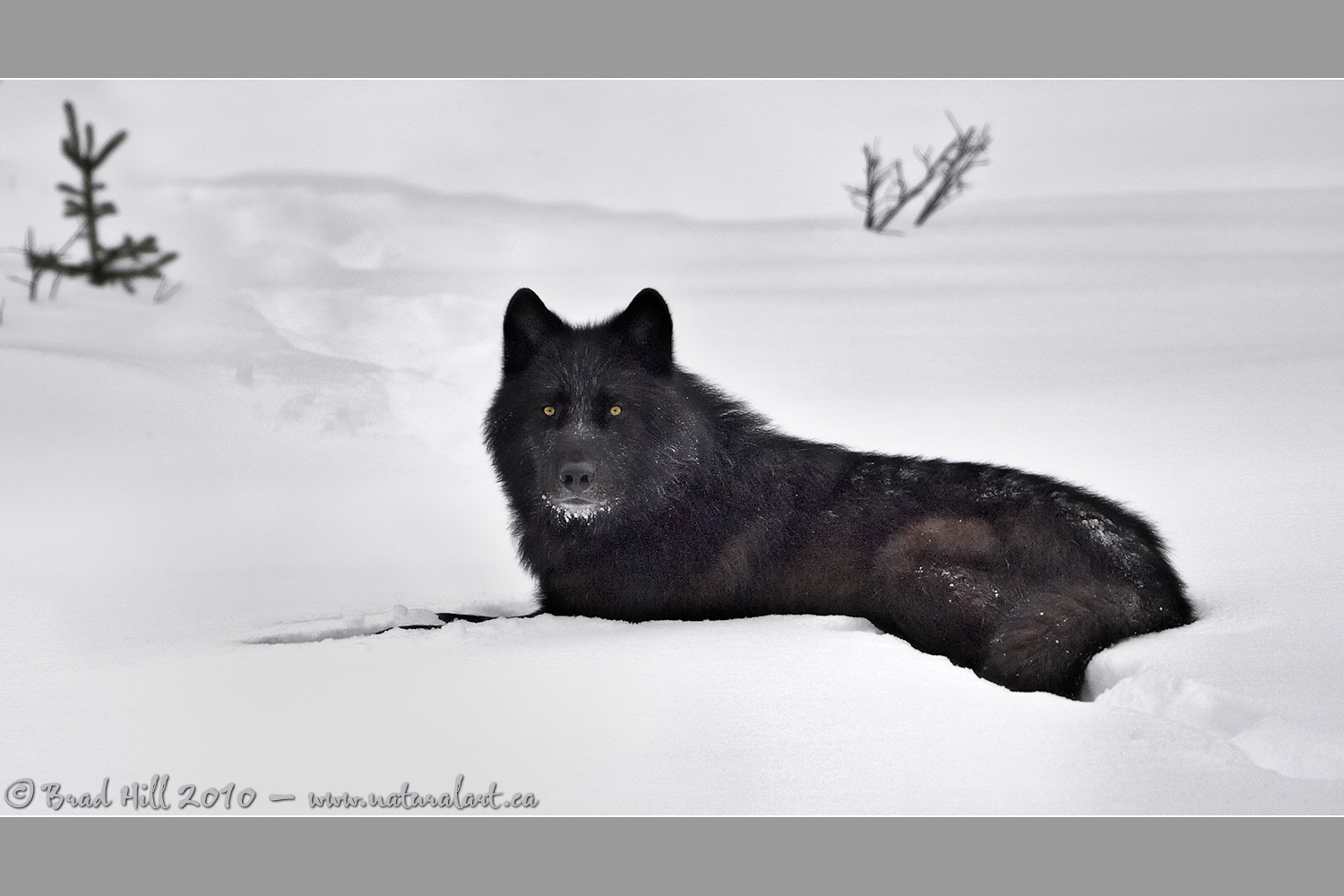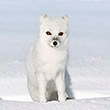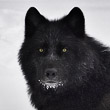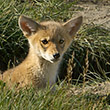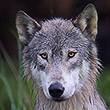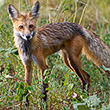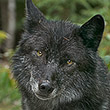Availability: Undetermined - Enquiries?
In the Field
Black Wolf, White Snow. Southern Rocky Mountains, BC, Canada. February 7, 2010.
Sometimes I think I have more horseshoes up my butt (i.e., I'm luckier) than anyone else on the planet. While I won't hesitate to photograph captive or "behaviourally-manipulated" animals (think birds at a feeder) for practice or to test new equipment, I do all my "real" wildlife photography using totally wild and completely unrestrained subjects. Where I live in the southeast corner of BC wolves are under continual attack from humans - at most elevations there is no closed season on killing them and there's not even a requirement to take the effort to get a wolf tag. And, to make matters worse, in recent years the bag limit has gone up (or been removed altogether). Consequently, the few wolves that ARE still around tend to be incredibly wary of humans. So the chances of seeing one, let alone photograph one is practically nil. Nonetheless, I decided early one Sunday morning in 2010 to treat myself and go look for the proverbial "needle in the haystack", i.e., to look for a wolf in southeast BC. Long story short (the long version is explained elsewhere on this website - see February 8, 2010 entry on my blog), in a few hours I actually FOUND a pair of wolves and one of them wasn't terrified of me (if having it casually trot toward you and end up within 15 feet of you can be considered non-terrified). Anyways, this shot is an outcome of this amazing and incredibly lucky encounter...
While this is a very simple shot - some may even say call it a "snapshot" - it was incredibly difficult to capture and LOT of things had to go right to make it come together. While probability of capturing a particular image is only a weak correlate of image quality and/or image value, there were so many odds stacked against me in producing this image that it is already destined to become one of my personal favourite images!
When I stumbled upon the pair of wolves one of them instantly took off. This black one, however, trotted only a few feet away and laid down. I was carrying my 600mm f4 lens and camera in a backpack (with tripod strapped to the side) and I whipped it off and extracted my camera as fast as I could. I decided to hand-hold the lens and "crack off" a few shots of the wolf before taking the time to unhook and set-up my tripod. About 45 seconds and 17 shots later I was still hand-holding the lens and the wolf was happily trotting away. I was SO GLAD I didn't fumble with my tripod and miss everything and decided to crack off a few shots first. Good decision #1!
So what was so difficult in capturing this shot? First, let's talk exposure. This scene absolutely maxed out the dynamic range (brightness range the image sensor can record) of my Nikon D700 - it's hard to imagine a scene where you need MORE highlight detail AND shadow detail in a single frame! I relied on Matrix metering (uncompensated) for the very first exposure (simply to ensure I got at least one shot) and the took a very quick glance at the image histogram, fully expecting the wolf would be considerably under-exposed. Yep - dead-on on that guess - many dark tones gonzo (one hump on the histogram stacked against the left side of the graph) and I knew from past experience there was sufficient space on the right side of the histogram to increase the exposure by at least a stop without losing the white-on-white detail on the snow. So I quickly cranked the exposure up one stop and shot away...
Second, let's talk long-lens-holding technique and camera settings. Even though image stabilization technology (VR in Nikon-speak and IS in Canon-talk) is amazingly good these days, hand-holding a 600mm f4 lens is no easy task. The very weight of the lens (over 11 lbs, sans camera) is tough to support for long, let alone without some shake. I had anticipated the potential need for high shutter speed (to offset camera shake) when I loaded my camera in my pack (if I had the need for a "quick grab" image) and set my aperture wide open AND dialed up the base ISO to 400 (the Nikon D700 and D3 or D3s still have a phenomenal dynamic range at ISO 400). Together, the forethought to set my camera this way AND the amazing performance of the VR system of this lens combined to give me at least a chance to get this shot (it would have been SO easy to miss this shot). Ultimately a little pre-planning put me in a position where I had little to think about (and adjust) other than getting the exposure right...
Third, a little on the processing of this image. If you saw the raw file for this image (or a JPEG preview of it) it would have been REALLY easy to chuck it out. But, based on the thousands of images I have processed, I knew there was enough image data here to "extract" a pretty decent image. In fact, when I shot the first image in the sequence and quickly checked the histogram I was already thinking about image data and what I could do with the processing. I call this feedback loop from what one has learned during image processing and how it affects (or SHOULD affect) your image capture techniques the "big feedback loop" (as opposed to the instant feedback loop of shooting and looking at your histogram). In this case I knew that I wanted to ensure that the subtle dark tones on the wolf were all captured and available to work with. Ultimately, returning this image to the state approximating what I observed in the field took a LOT of work (primarily returning the snow to how it looked on that overcast morning), but I like the final outcome...
Just a simple snapshot - right? Yeah, sure...and pigs can fly...
Behind the Camera
Black Wolf, White Snow. Southern Rocky Mountains, BC, Canada. February 7, 2010.
Digital Capture; Compressed RAW (NEF) format; ISO 400.
Nikon D700 with Nikkor 600 mm f/4G ED-IF AF-S VR lens - handheld. VR on and set to "Normal" mode.
1/2500s @ f4; +1.0 stop compensation from matrix-metered exposure setting of camera.
At the Computer
Black Wolf, White Snow. Southern Rocky Mountains, BC, Canada. February 7, 2010.
RAW Conversion to 16-bit TIFF, including first-pass/capture sharpening using Phase One's Capture One Pro 5. Two RAW conversions at different exposure settings. Exposure settings of +0.3 stops (on snow) and +1.5 stops (to extract shadow detail on coat of wolf).
Further digital corrections on 16-bit TIFF file using Adobe's Photoshop CS4 and Light Craft's LightZone. Photoshop adjustments included compositing and masking of 2 exposure versions, selective saturation and de-saturation of colours, selective highlight/shadow adjustment and selective sharpening for web output. Final tonemapping and balancing and tweaking of tones performed using the Tonemapper/Re-light tool in LightZone.
Conservation
Black Wolf, White Snow. Southern Rocky Mountains, BC, Canada. February 7, 2010.
Ten percent of the revenue generated by this image will be donated to Wildsight.
Species Status in Canada*: Only Eastern Wolf listed as species of "Special Concern" in May, 2001. Other populations not listed as Endangered or Threatened.
Species Status in the United States: Western Great Lakes population removed from list of Endangered and Threatened species on January 29, 2007. Proposed delisting of Northern Rockies population on January 29, 2007. Both actions are a direct result of a successful recovery plan. Congratulations! Wolves in other areas of the lower 48 states (including the Southwest wolf population), remain on Endangered Species list.
Probably no species alive today has suffered as much direct persecution from humans as has the Gray Wolf (Canis lupus). Once extremely widespread in North America, the Gray Wolf was virtually extirpated from the contiguous 48 states of America and now is regularly found within only a fraction of its historical range in Canada. While the Gray Wolf is currently listed as endangered in most of the 48 lower states of the United States and enjoys the privileges associated with such status (if lack of persecution and abuse can be thought of as a privilege), it is still official policy in much of Canada to rid the countryside of this magnificent keystone predator. As an example, in British Columbia, there is NO closed season on the wolf in most hunting jurisdictions and opportunistic slaughter is encouraged by policy (it is the ONLY fur-bearing species for which NO hunting license is required in British Columbia!). Conservation of wolves presents a puzzling paradox. Reduced to the most basic principles, wolf conservation is simplistic: we need only to stop persecuting this species in order for it to survive. Yet accomplishing this invariably proves incredibly difficult - it's as though wolf persecution has been institutionalized directly into government (and societal) bureaucracy.
I commend and support those individuals and groups that have the patience and determination to fight for the Gray Wolf. This wolf was photographed in the Columbia Valley of southeast British Columbia. Wildsight is an effective conservation organization that protects biodiversity and promotes sustainable communities in Canada's Columbia and Rocky Mountains. Support for Wildsight, through donation or becoming a member, will help ensure that they remain effective in their efforts to conserve threatened or endangered species and ecosystems.
*as determined by COSEWIC: The Committee on the Status of Endangered Wildlife in Canada












